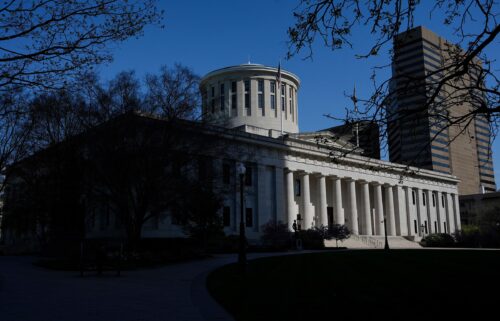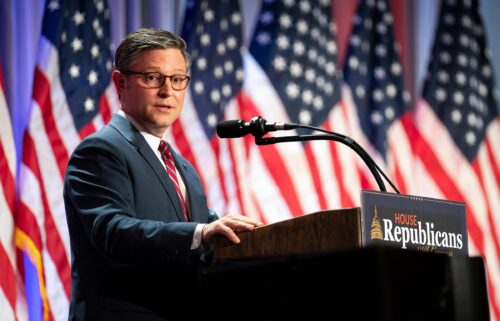Without Trump’s help, America’s other leaders go it alone in the fight against climate change
President Donald Trump’s move to begin pulling out of the Paris Agreement last month signaled to world leaders that the US government is stepping away from the global push to stop the climate crisis.
But as world leaders gather in Madrid this week to refine their pledges to cut heat-trapping gases, a large group of US cities, states, universities and businesses remain committed to holding global warming below 2 degrees Celsius.
Their message to the world? That the US is still fighting to avoid the worst consequences of climate change.
And despite the policies of this administration, a new report shows that this broad coalition is significantly reducing US greenhouse gas emissions and even deeper cuts are possible with or without federal help.
The report titled “Accelerating America’s Pledge” finds that policies already in place by state, local and business actors can reduce greenhouse gas emissions by 25% by 2030 compared to 2005 levels.
This current coalition of the willing represents 68% of US gross domestic product, which would make it the world’s second largest economy, second to only the US economy itself, according to the report.
“We can say to the international community, ‘Hey, you guys hear a lot about what’s not happening in the US, but what you might not know is that there is a tremendous amount of activity that can actually make a difference in terms of overall US emissions,'” said Nate Hultman, director of the Center for Global Sustainability at the University of Maryland and the lead author of the report.
The authors of the report — which was produced by the “America’s Pledge” initiative led by Democratic presidential candidate Michael Bloomberg and former California Gov. Jerry Brown — found that even more significant cuts are possible with further shifts toward renewable energy, improved efficiency in buildings and transportation, and protection of forests and other carbon-storing ecosystems.
If state and local governments along with the private sector further enhanced their climate commitments, overall US emissions could fall even further by 37% by 2030, the study found.
But the report shows that to get the US within striking distance of its Paris Agreement goals, executive and legislative action will be required.
Mixed messages from the US on climate change
The report comes as state and local actors try to carry on the fight to halt climate change without federal support and reflects both the potential and limits of this current bifurcated US climate policy.
At this week’s United Nations’ 25th Conference of Parties (COP25) in Madrid — where countries are attempting to iron out more aggressive commitments to slash emissions of planet-warming gases — there is an interesting dynamic at play, with two groups representing US interests on the ground.
A delegation of State Department and other federal officials sent by the Trump administration is in Madrid for the negotiations, where they plan to “… ensure a level playing field that protects US interests,” according to a State Department statement.
But there is a second group from the US in Madrid — a band of lawmakers, city and state officials, plus private sector and educational leaders — seeking to fill the void of leadership they say has been left by the Trump administration.
Their goal is to convince the rest of the world that the US is still in the fight to avert the worst consequences of climate change.
Last Monday at the start of the talks, US House Speaker Nancy Pelosi led a group of Democratic lawmakers to Madrid “to reaffirm the commitment of the American people to combating the climate crisis.”
On Friday, the US Climate Action Center opened in Madrid with a slate of speakers and events. During COP25, the action center will serve as a hub for an array of US leaders planning to show other countries the steps they are taking to combat the climate crisis.
“Throughout the course of history, the US has been seen as a leader. And with an issue as pressing as this one, we shouldn’t take a backseat to anybody,” said Wisconsin Lt. Gov. Mandela Barnes, who is representing the US Climate Alliance, a bipartisan coalition of governors committed to the Paris Agreement goals.
In the absence of federal action to address the climate crisis, this has become the new normal.
At the past two major gatherings of climate negotiators (COP23 and COP24) since Trump came into office, this alliance has set up shop on the sidelines –separate from the federal delegation.
Still, their goal of convincing the world that the country is taking the threat of global warming seriously will not be easy. The US has left the last two international climate agreements and remains the world’s second-largest contributor of planet-warming gases.
“One of the major concerns I think is the way that the US has participated in these talks — being in and being out, and then being in and being out,” said Elan Strait, director of US climate campaigns at the World Wildlife Fund. “The rest of the world is obviously very tired of that.”
Why 2020 matters for climate action
Both in the US presidential election and at next year’s COP26 in Glasgow, the stakes are high when it comes to the fate of the planet.
The Madrid meetings this week are the last major negotiations before 2020, the year when the Paris agreement goes into effect.
When nations signed the deal back in 2015, they agreed global emissions of greenhouse gases must peak by 2020 and then start falling or the world will face disastrous and irreversible damage.
Ahead of COP26, many countries will need to increase their commitments to cut emissions to get on track to meet the Paris goals.
A recent United Nations report showed that the current commitments are not enough to stave off catastrophic levels of global warming.
Though the US has formally withdrawn from the Paris accord, under the agreement’s framework, the process cannot be completed until November 4, 2020, which happens to be the day after the 2020 presidential election.
Should Trump lose, a new president could rejoin the agreement, but would need to commit the US to cutting its heat-trapping gas emissions even further.




